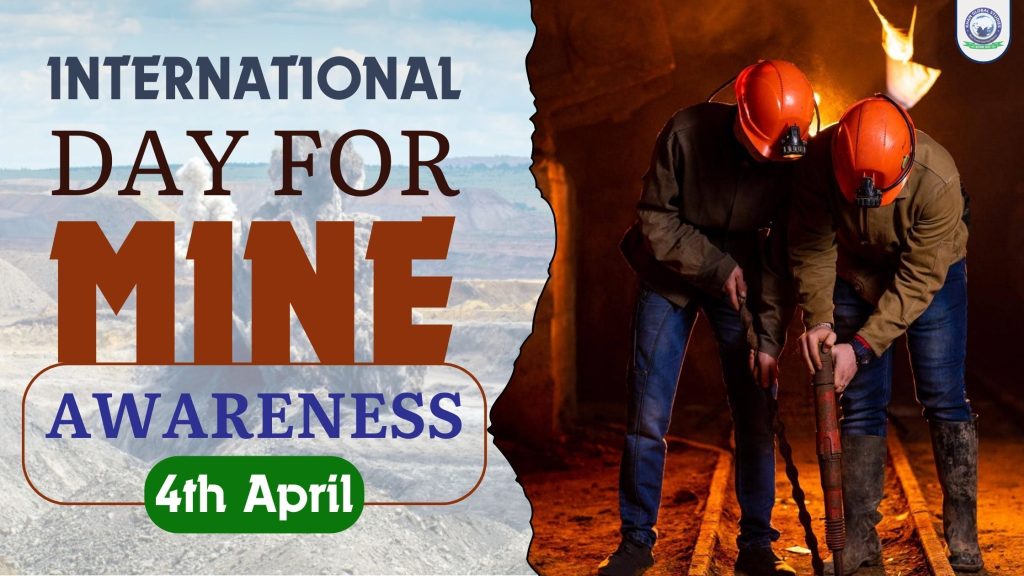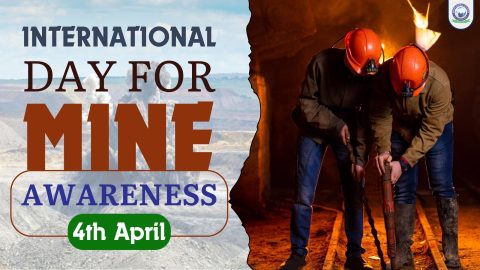The International Day of Mine Awareness and Assistance in Mine Action is observed annually on April 4th. The primary objective of this day is to raise awareness about the dangers posed by landmines and explosive remnants of war (ERW) and to support efforts in their removal.
History and Significance
The United Nations (UN) declared this day on December 8, 2005, and it has been observed globally since 2006. It focuses on ensuring the safety of people living in war-affected regions, rehabilitating land, and assisting affected communities.
What Are Landmines?
Landmines are hidden explosive devices placed either underground or on the surface. They detonate when pressure is applied by a person or a vehicle. These mines are primarily used during wars, but even after conflicts end, they remain buried in the ground, posing a severe threat to civilians.
Types of Landmines
- Anti-Personnel Mines (APM): Designed specifically to harm individuals, these mines can explode with minimal pressure.
- Anti-Vehicle Mines (AVM): These mines are intended to damage or destroy heavy vehicles and explode under greater pressure.
- Improvised Explosive Devices (IEDs): Often used by insurgent groups and terrorist organizations, these mines can be remotely detonated.
Impact of Landmines
- Civilian Deaths and Disabilities: Every year, thousands of innocent people, including children, fall victim to landmines, resulting in death or permanent disabilities.
- Economic Losses: Agricultural land rendered unusable due to landmines leads to poverty and hunger in affected areas.
- Impact on Education and Development: Mines near schools, roads, and hospitals prevent people from accessing essential services, hindering overall development.
- Psychological Impact: The fear of landmines causes mental stress and insecurity among people living in conflict-affected regions.
Significance of the International Day of Mine Awareness
- Encourages global efforts for landmine removal and assistance to affected individuals.
- The UN and various organizations conduct programs for mine clearance, victim support, and rehabilitation.
- Aims to create a world where no one has to live under the threat of landmines.
How Is This Day Observed?
- Educational and Awareness Campaigns: Seminars and workshops are conducted in schools, colleges, and social organizations to educate people about landmine risks and safety measures.
- Scientific and Technological Advancements: New tools and technologies are being developed to detect and deactivate landmines efficiently.
- Support from Developed Countries: The UN and developed nations assist war-torn countries in mine clearance and rehabilitation efforts.
- Social Media Campaigns: Hashtags like #MineAwareness and #SafeGround are used to spread awareness about landmine-related issues.
- Support Programs for Victims: Rehabilitation programs and prosthetic limb assistance for those who have lost their limbs due to landmines.
United Nations and Mine Clearance Efforts
- UNMAS (United Nations Mine Action Service)
- Assists in identifying and clearing landmines.
- Provides financial and technical support to mine-affected countries.
- ‘Safe Ground, Safe Steps, Safe Home’ Initiative: Aims to create a landmine-free world and support victims.
- Mine Ban Treaty (1997):
- Also known as the Ottawa Treaty, this agreement bans the production, storage, and use of landmines.
- 164 countries have signed this treaty.
- International Campaign to Ban Landmines (ICBL): A non-governmental organization (NGO) working for the complete elimination of landmines worldwide.
Major Landmine-Affected Countries
Even today, many countries are severely struggling with the issue of landmines. These mines not only pose a constant threat to civilians but also hinder the social and economic development of nations. Due to wars and conflicts, the problem of landmines has worsened over time. The following countries are among the most affected by landmines:
- Afghanistan: Afghanistan has been facing wars and conflicts for decades, leading to a large number of landmines being planted across the country. Even today, these landmines remain a serious threat to people, especially in rural and mountainous regions.
- Cambodia: During the civil war in the 1970s and 1980s, millions of landmines were laid across Cambodia. The problem persists in many parts of the country, causing loss of life and property.
- Iraq: Due to several wars over the past few decades, Iraq has a significant number of landmines and unexploded ordnance (UXOs) buried in the ground. The problem is particularly severe in regions where conflicts between terrorist organizations and the military have taken place.
- Syria: Syria has been engulfed in a prolonged civil war, resulting in landmines being scattered across the country. Even after the war, many areas remain filled with explosive devices, posing a deadly threat to civilians.
- Yemen: The ongoing conflict in Yemen has led to the widespread use of landmines. These mines are not only dangerous for civilians but also pose a major threat to farmers and children who unknowingly step on them.
- Colombia: During Colombia’s decades-long armed conflict, a vast number of landmines were planted. The issue is particularly severe in rural areas, where people face the risk of accidents while farming or performing daily activities.
- African Countries: Several African nations are also severely affected by the problem of landmines, including:
- Angola: Many rural areas still have the threat of landmines.
- Sudan: The country’s prolonged civil war has left many regions contaminated with landmines.
- Somalia: Due to terrorism and conflict, Somalia faces a serious landmine problem.
- Mozambique: International organizations are carrying out demining operations to clear landmines that were planted during past wars.
Solutions and Efforts
To address this crisis, the United Nations and various international organizations are actively working to remove landmines in these countries. These efforts include:
- Identifying and deactivating landmines
- Raising awareness among civilians about the dangers of landmines
- Providing support to landmine survivors
- However, this is a long and challenging process, but international cooperation continues to help these nations overcome this crisis.
Key Facts
- Around 5,000 people die from landmines every year, with over 50% being children.
- Landmines still exist in approximately 60 countries.
- It costs only $3 to $10 to plant a landmine, but removing one costs between $300 and $1,000.
- The most heavily landmine-contaminated countries are Afghanistan, Cambodia, and Angola.
Conclusion
The International Day of Mine Awareness and Assistance in Mine Action is more than just a day of awareness—it is a call to action. It highlights the importance of helping landmine victims, rehabilitating affected land, and ensuring global safety.
We must continue to educate ourselves about this issue, support mine clearance operations, and assist landmine survivors. Until the world is completely free from landmines, these efforts must continue.





